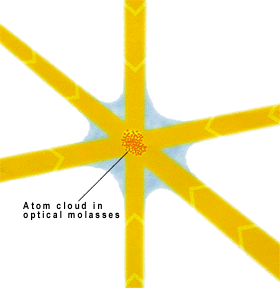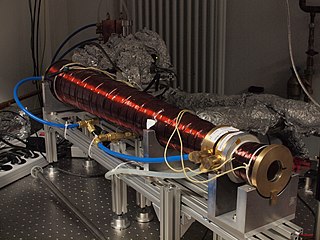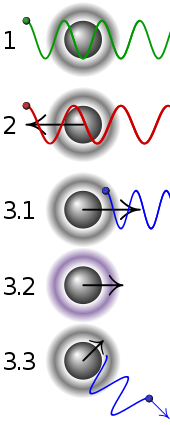
Radiation pressure is the mechanical pressure exerted upon any surface due to the exchange of momentum between the object and the electromagnetic field. This includes the momentum of light or electromagnetic radiation of any wavelength that is absorbed, reflected, or otherwise emitted by matter on any scale. The associated force is called the radiation pressure force, or sometimes just the force of light.

Photoluminescence is light emission from any form of matter after the absorption of photons. It is one of many forms of luminescence and is initiated by photoexcitation, hence the prefix photo-. Following excitation, various relaxation processes typically occur in which other photons are re-radiated. Time periods between absorption and emission may vary: ranging from short femtosecond-regime for emission involving free-carrier plasma in inorganic semiconductors up to milliseconds for phosphoresence processes in molecular systems; and under special circumstances delay of emission may even span to minutes or hours.

Laser cooling includes a number of techniques in which atoms, molecules, and small mechanical systems are cooled, often approaching temperatures near absolute zero. Laser cooling techniques rely on the fact that when an object absorbs and re-emits a photon its momentum changes. For an ensemble of particles, their thermodynamic temperature is proportional to the variance in their velocity. That is, more homogeneous velocities among particles corresponds to a lower temperature. Laser cooling techniques combine atomic spectroscopy with the aforementioned mechanical effect of light to compress the velocity distribution of an ensemble of particles, thereby cooling the particles.
Plasma diagnostics are a pool of methods, instruments, and experimental techniques used to measure properties of a plasma, such as plasma components' density, distribution function over energy (temperature), their spatial profiles and dynamics, which enable to derive plasma parameters.
Resolved sideband cooling is a laser cooling technique allowing cooling of tightly bound atoms and ions beyond the Doppler cooling limit, potentially to their motional ground state. Aside from the curiosity of having a particle at zero point energy, such preparation of a particle in a definite state with high probability (initialization) is an essential part of state manipulation experiments in quantum optics and quantum computing.

A trapped ion quantum computer is one proposed approach to a large-scale quantum computer. Ions, or charged atomic particles, can be confined and suspended in free space using electromagnetic fields. Qubits are stored in stable electronic states of each ion, and quantum information can be transferred through the collective quantized motion of the ions in a shared trap. Lasers are applied to induce coupling between the qubit states or coupling between the internal qubit states and the external motional states.

Optical molasses is a laser cooling technique that can cool neutral atoms to temperatures lower than a magneto-optical trap (MOT). An optical molasses consists of 3 pairs of counter-propagating circularly polarized laser beams intersecting in the region where the atoms are present. The main difference between optical molasses and a MOT is the absence of magnetic field in the former. Therefore, unlike a MOT, an optical molasses provides only cooling and no trapping. While a typical Sodium MOT can cool atoms down to 300μK, optical molasses can cool the atoms down to 40μK, an order of magnitude colder.

In condensed matter physics, a magneto-optical trap (MOT) is an apparatus which uses laser cooling and a spatially-varying magnetic field to create a trap which can produce samples of cold, neutral atoms. Temperatures achieved in a MOT can be as low as several microkelvin, depending on the atomic species, which is two or three times below the photon recoil limit. However, for atoms with an unresolved hyperfine structure, such as 7Li, the temperature achieved in a MOT will be higher than the Doppler cooling limit.

An atomic line filter (ALF) is a more effective optical band-pass filter used in the physical sciences for filtering electromagnetic radiation with precision, accuracy, and minimal signal strength loss. Atomic line filters work via the absorption or resonance lines of atomic vapors and so may also be designated an atomic resonance filter (ARF).
In condensed matter physics, an ultracold atom is an atom with a temperature near absolute zero. At such temperatures, an atom's quantum-mechanical properties become important.

In ultra-low-temperature physics, Sisyphus cooling, the Sisyphus effect, or polarization gradient cooling involves the use of specially selected laser light, hitting atoms from various angles to both cool and trap them in a potential well, effectively rolling the atom down a hill of potential energy until it has lost its kinetic energy. It is a type of laser cooling of atoms used to reach temperatures below the Doppler cooling limit. This cooling method was first proposed by Claude Cohen-Tannoudji in 1989, motivated by earlier experiments which observed sodium atoms cooled below the Doppler limit in an optical molasses. Cohen-Tannoudji received part of the Nobel Prize in Physics in 1997 for his work. The technique is named after Sisyphus, a figure in the Greek mythology who was doomed, for all eternity, to roll a stone up a mountain only to have it roll down again whenever he got it near the summit.
Photoelectrochemical processes are processes in photoelectrochemistry; they usually involve transforming light into other forms of energy. These processes apply to photochemistry, optically pumped lasers, sensitized solar cells, luminescence, and photochromism.

In atomic physics, a Zeeman slower is a scientific instrument that is commonly used in atomic physics to slow and cool a beam of hot atoms to speeds of several meters per second and temperatures below a kelvin. The gas-phase atoms used in atomic physics are often generated in an oven by heating a solid or liquid atomic sample to temperatures where the vapor pressure is high enough that there are a substantial number of atoms in the gas phase. These atoms effuse out of a hole in the oven with average speeds on the order of hundreds of m/s and large velocity distributions. The Zeeman slower is attached close to where the hot atoms exit the oven and is used to slow them to less than 10 m/s (slowing) with a very small velocity spread (cooling).
Saturated absorption spectroscopy measures the transition frequency of an atom between its ground state and an excited state. In saturated absorption spectroscopy, two counter-propagating, overlapped laser beams are sent through a sample of atomic gas. One of the beams stimulates photon emission in excited atoms when the laser's frequency matches the transition's frequency. By changing the laser frequency until these extra photons appear, one can find the exact transition frequency. This method enables precise measurements at room temperature because it is insensitive to doppler broadening. Absorption spectroscopy measures the doppler-broadened transition, so the atoms must be cooled to millikelvin temperatures to achieve the same sensitivity as saturated absorption spectroscopy.
In atomic physics, Raman cooling is a sub-recoil cooling technique that allows the cooling of atoms using optical methods below the limitations of Doppler cooling, Doppler cooling being limited by the recoil energy of a photon given to an atom. This scheme can be performed in simple optical molasses or in molasses where an optical lattice has been superimposed, which are called respectively free space Raman cooling and Raman sideband cooling. Both techniques make use of Raman scattering of laser light by the atoms.
In optical physics, laser detuning is the tuning of a laser to a frequency that is slightly off from a quantum system's resonant frequency. When used as a noun, the laser detuning is the difference between the resonance frequency of the system and the laser's optical frequency. Lasers tuned to a frequency below the resonant frequency are called red-detuned, and lasers tuned above resonance are called blue-detuned.
Sub-Doppler cooling is a class of laser cooling techniques that reduce the temperature of atoms and molecules below the Doppler cooling limit. Doppler cooling processes have a cooling limit that is characterized by the momentum recoil from the emission of a photon from the particle.

Peter E. Toschek was a German experimental physicist who researched nuclear physics, quantum optics, and laser physics. He is known as a pioneer of laser spectroscopy and for the first demonstration of single trapped atoms (ions). He was a professor at Hamburg University.
Gray molasses is a method of sub-Doppler laser cooling of atoms. It employs principles from Sisyphus cooling in conjunction with a so-called "dark" state whose transition to the excited state is not addressed by the resonant lasers. Ultracold atomic physics experiments on atomic species with poorly-resolved hyperfine structure, like isotopes of lithium and potassium, often utilize gray molasses instead of Sisyphus cooling as a secondary cooling stage after the ubiquitous magneto-optical trap (MOT) to achieve temperatures below the Doppler limit. Unlike a MOT, which combines a molasses force with a confining force, a gray molasses can only slow but not trap atoms; hence, its efficacy as a cooling mechanism lasts only milliseconds before further cooling and trapping stages must be employed.















